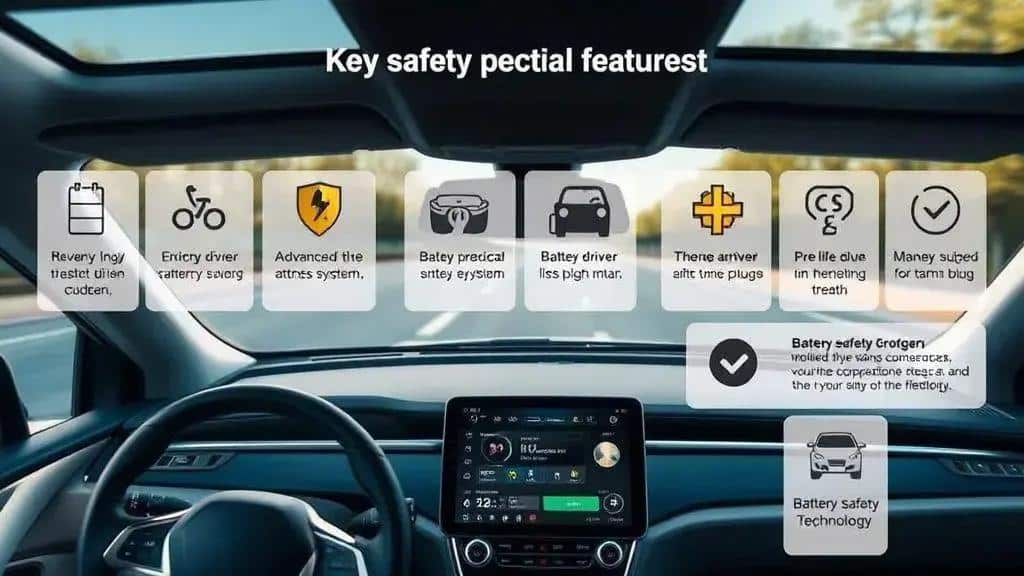EV safety advancements and crash test results: what you need to know

EV safety advancements involve innovative features like AI integration, enhanced battery protection, and rigorous crash testing, making electric vehicles safer and more environmentally friendly compared to traditional cars.
EV safety advancements and crash test results have become focal points as electric vehicles gain popularity. But how well do we really understand these innovations? Let’s dive into what makes today’s EVs safer than ever.
Overview of EV safety advancements
The overview of EV safety advancements reveals how rapidly the electric vehicle industry is evolving. Safety is a top priority, and understanding the latest improvements is essential for both manufacturers and consumers.
Significant Innovations
Some of the significant innovations in EV safety include:
- Advanced collision detection systems
- Enhanced battery management systems
- Improved structural integrity and crumple zones
These features are designed to protect both occupants and pedestrians in case of an accident. Knowing what these advancements are can help you make informed choices when purchasing an electric vehicle.
In addition to individual features, manufacturers are increasingly employing rigorous testing standards. The desire for higher safety ratings drives companies to innovate continuously. The National Highway Traffic Safety Administration (NHTSA) and the Insurance Institute for Highway Safety (IIHS) are crucial in this domain, regularly updating their ratings based on real-world performance data.
Examples of EV Manufacturers Leading the Charge
Companies like Tesla, Ford, and Nissan are pioneering the field with state-of-the-art technology. Tesla’s vehicles, for example, come equipped with unmatched autopilot capabilities, which significantly reduce the chances of collisions. Ford has integrated several driver-assist features in their EV lineup, enhancing user safety on the road.
As more people embrace electric vehicles, their safety features will only become more sophisticated. Staying informed about these advancements is vital, not just for safety but also for ensuring compliance with upcoming regulations.
Understanding the advancements in EV safety helps consumers feel more confident in their choices. The world of electric vehicles is changing fast, and being up-to-date ensures you’re not only safe but also well-informed.
Importance of crash test results
The importance of crash test results cannot be overstated in the world of electric vehicles (EVs). These tests play a critical role in ensuring that vehicles meet safety standards, and they provide valuable information to consumers.
Understanding Crash Test Ratings
Crash test ratings come from thorough evaluations conducted by organizations like the NHTSA and the IIHS. These ratings offer insights into how well an EV will perform in a collision. The tests assess factors such as:
- Frontal impact safety
- Side impact protection
- Rollover resistance
Each of these factors is vital for understanding the overall safety of a vehicle. When consumers can easily access this information, they can make informed purchasing decisions.
Moreover, crash test results help manufacturers identify areas for improvement. If a vehicle scores poorly in specific tests, engineers can analyze the data and enhance safety features in future models. This cycle of testing and improvement helps to advance safety technologies in the entire industry.
Real-World Impact of Crash Test Results
For many potential EV buyers, crash test results are crucial when comparing different models. High ratings often translate into greater consumer trust. Drivers want assurance that their vehicle can protect them in the event of an accident. When a vehicle earns high safety ratings, it’s often marketed as a key selling point.
Additionally, these results influence public policy and industry standards. Governments may use crash test outcomes to inform regulations, pushing manufacturers to prioritize safety in their designs. Thus, the ripple effects of crash test ratings stretch far beyond the showroom.
Understanding the importance of crash test results enables consumers to make safer choices while pushing manufacturers to enhance vehicle safety. As the electric vehicle market continues to grow, these tests will remain a cornerstone of vehicle safety assessment.
Key safety features in modern EVs

Modern electric vehicles (EVs) come equipped with several key safety features that enhance driver and passenger protection. These features are designed to address the unique risks associated with electric vehicles while also improving overall safety on the road.
Advanced Driver Assistance Systems (ADAS)
ADAS includes various technologies that support safer driving. Some examples of these features are:
- Adaptive cruise control
- Automatic emergency braking
- Lane departure warning
- Blind-spot monitoring
These systems help drivers stay aware of their surroundings, reducing the chances of accidents. By providing real-time feedback, they support safer driving habits.
Another critical element in modern EV safety is the vehicle’s structural integrity. Engineers design EVs with strong frames and crumple zones that absorb energy during a crash. This design protects occupants by directing impact forces away from the passenger cabin.
Battery Safety Technologies
Battery safety is particularly important in electric vehicles. Manufacturers incorporate features like thermal management systems and protective enclosures to reduce the risk of fire and explosion. Many EVs have passed stringent tests ensuring that their batteries perform safely under various conditions.
Additionally, features such as traction control and stability control improve the handling of electric vehicles. These systems help maintain stability during challenging driving situations, giving drivers confidence on the road.
As more manufacturers prioritize safety, the advancements in technology are expected to grow. Understanding these key safety features in modern EVs is essential for consumers who want to make informed choices about their vehicles.
Comparing traditional vehicles and EVs
Comparing traditional vehicles and electric vehicles (EVs) sheds light on the evolving automotive landscape. Each type of vehicle has its unique characteristics, benefits, and challenges that consumers must understand.
Fuel Efficiency and Costs
Traditional vehicles typically rely on gasoline or diesel, which can lead to fluctuating fuel costs. In contrast, EVs run on electricity, which often makes them cheaper to fuel. Further savings come from reduced maintenance needs in EVs due to fewer moving parts.
- Gasoline prices can vary greatly, affecting overall ownership costs.
- EV owners benefit from lower fuel costs and government incentives.
- Maintenance for EVs usually involves fewer routine checks.
Environmental Impact
When it comes to the environment, EVs have a significant advantage. They produce zero tailpipe emissions, contributing to cleaner air. Traditional vehicles, however, release greenhouse gases that can impact climate change. As the world shifts towards sustainability, this difference becomes increasingly important.
However, it’s essential to consider the production impact of batteries for EVs, which involve mining and manufacturing processes that can be harmful to the environment. Ongoing improvements in battery technology aim to minimize these effects.
In terms of performance, traditional vehicles often offer a wider variety of choices, especially for driving enthusiasts who appreciate the feel of a combustion engine. On the other hand, EVs provide instant torque, resulting in faster acceleration, making them enjoyable to drive as well.
Ultimately, when comparing traditional vehicles and EVs, it’s critical to weigh factors like cost, environmental impact, and driving experience. The best choice often depends on personal preferences and lifestyle needs, making it essential for consumers to assess their unique situations before making a decision.
Future trends in EV safety
Looking ahead, the future trends in EV safety are expected to evolve significantly as technology advances. As electric vehicles continue to gain popularity, manufacturers are focusing on enhancing safety features to ensure a safer driving experience for everyone.
Integration of Artificial Intelligence
One of the most exciting developments is the integration of artificial intelligence (AI) in safety systems. AI can improve collision detection and response times, allowing vehicles to react to potential hazards faster than human drivers. These systems will learn from a growing database of driving scenarios, enhancing their accuracy and effectiveness over time.
- AI can predict potential collisions by analyzing driving patterns.
- Smart algorithms help in providing real-time hazard alerts.
- Machine learning enables continuous improvement in safety features.
Enhanced Battery Safety Measures
As the battery technology matures, so does the focus on battery safety. Future trends indicate that manufacturers will deploy advanced design techniques and materials that can withstand higher impacts and reduce fire risks. Innovations such as solid-state batteries promise greater safety and efficiency compared to current lithium-ion models, making EVs even more reliable.
Moreover, manufacturers are also looking into automatic emergency systems that could isolate battery packs during a collision, minimizing the risk of thermal runaway incidents. As a result, EVs will be safer not just for their occupants, but also for pedestrians and other road users.
Regulatory Changes and Industry Standards
Regulatory bodies are also expected to play a key role in shaping the future of EV safety. More stringent safety standards will likely be implemented as electric vehicles become more widespread. Compliance with these standards will motivate manufacturers to innovate continuously.
As the automobile market changes, the focus will shift towards creating a more collaborative approach among automakers. This collaboration would aim to share safety data, leading to improved technologies across the board. The demand for connected vehicles equipped with vehicle-to-everything (V2X) communication technology may enhance safety by enabling cars to communicate with each other and their surroundings, providing critical information on road conditions and hazards.
Overall, the future of EV safety looks promising, as innovation and collaboration shape a safer driving environment for everyone involved.
In conclusion, the advancements in electric vehicle (EV) safety are transforming the way we think about transportation. With key innovations like AI integration and enhanced battery safety, modern EVs are becoming safer for everyone on the road. The focus on sustainability and stringent regulations further drive the evolution of EV technology. As more consumers choose electric vehicles, understanding these developments will help make informed decisions. Embracing the future of transportation means prioritizing safety and adapting to new technologies for a better driving experience.
FAQ – Frequently Asked Questions about EV Safety Advancements
What are some key safety features in modern electric vehicles?
Modern electric vehicles include advanced driver assistance systems, enhanced structural integrity, and improved battery safety measures.
How do EV crash test results impact consumer decisions?
Crash test results provide critical information on the safety of vehicles, helping consumers make informed choices about their purchases.
What role does artificial intelligence play in EV safety?
Artificial intelligence enhances collision detection and response times, significantly improving overall safety in electric vehicles.
Are electric vehicles more environmentally friendly than traditional cars?
Yes, electric vehicles produce zero tailpipe emissions, making them a cleaner option compared to traditional gasoline or diesel vehicles.





